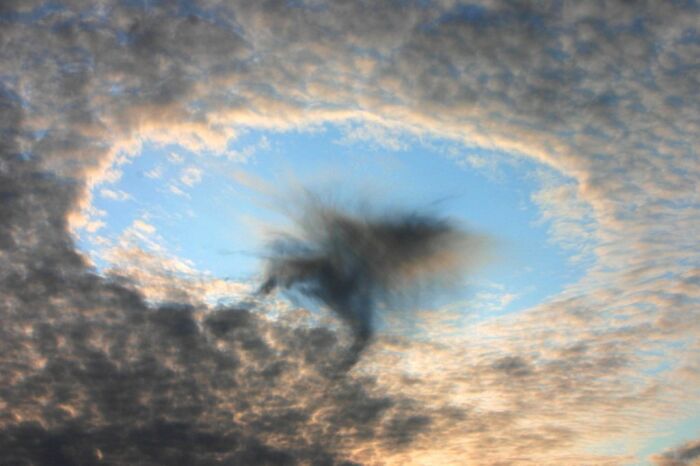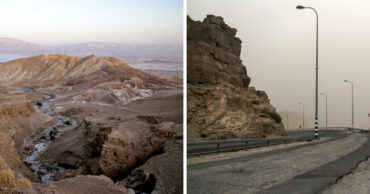Nature is capable of the most mysterious, surreal, stunning, and powerful things. The only thing we can do as humans is to watch and admire them. However, in our short time here on Earth, it’s quite impossible to see and experience it all.
We at Bored Panda compiled a list of the most unique, dangerous, and beautiful natural phenomena so that everyone can get a glimpse into the wonders of our world. Scroll down to find them and be sure to upvote the ones that mesmerized you the most.
While you’re at it, don’t forget to check out a conversation with environmental scientist and sustainability consultant, Dr. Jennifer Brandon, and climate scientist and founder of New Climate Culture, Eloisa Lewis, who kindly agreed to talk with us more about the dangerous side of natural phenomena.
#1 Eternal Flame Falls
Eternal Flame Falls is a small waterfall located in New York’s Chestnut Ridge Park, known for its natural gas seepage that keeps a small flame burning at its base. The flame is fueled by methane gas escaping from beneath the waterfall, creating a unique, continuously burning fire amidst the flowing water. This phenomenon is a rare and fascinating combination of geology and nature.

Image source: Mpmajewski
#2 Marble Caves, Chile
Stunning series of caverns carved into solid marble by water over thousands of years. Located on Lake General Carrera, the caves are renowned for their striking blue and white veined marble formations, creating a surreal, otherworldly landscape.

Image source: Dan Lundberg
#3 Volcanic Lightning
Volcanic lightning is an electrical discharge triggered by a volcanic eruption, not a typical thunderstorm. It forms when ash particles collide and fragment, generating static electricity within the volcanic plume. Moist convection and ice formation can also contribute to the phenomenon, sometimes occurring even without ice crystals in the cloud.

Image source: Terje Sorgjerd
#4 Dragon Tree In Socotra, Yemen
This tree is a rare phenomenon due to its unique appearance and the red sap it produces. It can live for hundreds of years, thrives in the island’s harsh, dry climate and is part of the island’s exceptional and isolated ecosystem.

Image source: Alex38
#5 Nacreous Clouds
Nacreous clouds, also known as “mother-of-pearl” clouds, are high-altitude clouds that form in the stratosphere, typically at altitudes of 15 to 25 kilometers, and are most commonly observed in polar regions during winter. They appear iridescent due to the diffraction of sunlight by tiny ice crystals within the clouds, creating colorful, shimmering patterns.

Image source: Alan R. Light
#6 Sandstone Waves, Arizona
These unique sandstone structures were shaped by erosion over millions of years, creating a visually striking landscape that attracts photographers and hikers.
![]()
Image source: Gb11111
#7 Giant’s Causeway, Ireland
Geological phenomenon formed by about 40,000 interlocking basalt columns, created from volcanic activity around 60 million years ago.

#8 Goats In An Argan Tree, Morocco

Image source: Elena Tatiana Chis
#9 Pink Beach, Padar Island, Komodo National Park
It is famous for its unique pink-hued sand, which is created by the mixture of white sand and red coral fragments. This stunning beach is part of a UNESCO World Heritage site, known for its rich biodiversity, including the famous Komodo dragons and vibrant marine life.

Image source: Devagonal
#10 Aurora Australis
Aurora Australis, or the Southern Lights, is a natural light display caused by solar wind particles colliding with Earth’s magnetic field. This creates colorful lights in the sky, typically green and red, near the South Pole. It is most visible in high-latitude regions like Antarctica and southern Australia.

Image source: Ross Burgener
#11 Tunnel Of Love, Ukraine
In the small western Ukrainian town of Klevan, a stretch of industrial railway is enveloped by lush, leafy arches, creating a picturesque scene. This enchanting spot has become a favorite for couples to stroll through, earning it the name “Tunnel of Love” (or Tunel Kokhannya).

Image source: serhei
#12 Fire Whirl Tornado
A fire whirl, or fire tornado, is a whirlwind created by intense heat and wind from a fire, often visible with smoke and flames. It forms when rising heat and turbulent winds create spinning air currents, which can intensify into a tornado-like vortex. This vortex may pull in debris and gases, adding to the intensity of the fire.

Image source: Jan van Rooyen
#13 Aurora Borealis
The Aurora Borealis, or Northern Lights, is a natural light display caused by solar wind particles interacting with Earth’s magnetic field. This creates vibrant colors in the night sky, visible in polar regions like Norway, Sweden, and Canada. It is most commonly seen during winter months.

Image source: Senior Airman Joshua Strang
#14 Salar Of Uyuni, Bolivia
Salar de Uyuni is the world’s largest salt flat, formed from the remnants of an ancient lake that evaporated long ago. The vast, flat expanse creates a stunning mirror effect after rainfall, reflecting the sky and surrounding landscape, making it a popular natural wonder.

Image source: Christopher Crouzet
#15 Moonbow
A moonbow, also called a moon rainbow or lunar rainbow, is a rainbow created by moonlight instead of direct sunlight. Aside from the difference in the light source, its formation follows the same process as a solar rainbow: light is refracted through numerous water droplets, like those from a rain shower or waterfall. It always appears on the opposite side of the sky from the Moon, as seen by the observer.

Image source: Arne-kaiser
#16 Jigokudani Hot Spring, Nagano, Japan
Famous for its natural hot springs surrounded by a picturesque, mountainous landscape. The area is known for the wild Japanese macaques, or snow monkeys, who can be seen soaking in the warm waters, especially during the cold winter months. The name “Jigokudani,” meaning “Hell Valley,” refers to the steamy, volcanic landscape that creates the unique thermal environment of the hot springs.

Image source: Yosemite
#17 Kjeragbolten Boulder, Norway
This iconic rock formation is a massive boulder wedged between two cliffs.

Image source: dziambel
#18 The Cave Of Crystals, Mexico
A network of caves is filled with enormous selenite crystals, some of the largest natural crystals ever discovered on Earth. Due to the extreme environmental conditions, the caves remain mostly unexplored and are currently closed to the public.

Image source: Alexander Van Driessche
#19 Rainbow Eucalyptus
These trees color variations occur as the tree sheds its bark, exposing new layers that gradually change color due to exposure to air and sunlight. They are primarily found in tropical regions like Hawaii, the Philippines, and Indonesia.

Image source: Plant pests and diseases
#20 Light Pillars And Diamond Dust In London Ontario Canada
Light pillars occur when ice crystals in the air reflect artificial light sources, such as streetlights, creating vertical shafts of light, while diamond dust is made up of tiny ice crystals suspended in the air, producing a sparkling, glittering effect when sunlight or moonlight interacts with them.

Image source: Ray Majoran
#21 Coral Reef
Coral reefs are diverse underwater ecosystems formed by the calcium carbonate skeletons of coral organisms, often referred to as “the rainforests of the sea.” They support a wide variety of marine life, providing shelter and food for thousands of species, and are vital to coastal protection and marine biodiversity. However, coral reefs are increasingly threatened by climate change, pollution, and overfishing, leading to coral bleaching and ecosystem degradation.

Image source: USFWS Pacific
#22 Sailing Stones
Large rocks that mysteriously move across the dry lakebeds of places like California’s Death Valley. This phenomenon occurs when a combination of ice, wind, and water creates conditions that allow the stones to slowly slide across the ground. The tracks left by the stones can remain visible for years.

Image source: Romain Guy
#23 Lenticular Clouds
Lenticular clouds, named for their lens or saucer-like shape, are stationary clouds that form in the troposphere, often aligned with the wind direction. These clouds come in three main types based on their altitude and can sometimes appear in the lower stratosphere as nacreous clouds.

Image source: NPGallery
#24 Dark Hedges
Bregagh Road in County Antrim, Northern Ireland, is famously known as the Dark Hedges, thanks to its enchanting row of beech trees planted in the 18th century by the Stuart family. Fans of HBO’s Game of Thrones might also recognize it as the “Kings Road” from the series.

Image source: Colin Park
#25 The Crooked Forest, Poland
Located in a small area of western Poland, Krzywy Las the “Crooked Forest” is home to hundreds of peculiarly bent pine trees. Planted in the 1930s near the town of Gryfino, the cause of their unusual shapes remains unclear, though many believe human intervention may have played a role in their curving form.

Image source: 7alaskan
#26 One Year Ago During New Year’s Eve Nature Showed A Special Light Show Of Its Own For Us – Unique Phenomena Called Polar Stratospheric Clouds, Norway

Image source: Fishermang
#27 Pele’s Hair Lava
Greenish-gold strands of Pele’s hair form when bubbles in hot lava pop and throw droplets into the wind. The droplets can elongate into perfectly straight, glassy strands that are as thin as human hair.

Image source: NASA/GSFC/Andrea Jones
#28 Avenue Of The Baobabs
The route between Morondava and Belon’i Tsiribihina in Madagascar is flanked by magnificent baobab trees, known as the “Avenue of the Baobabs.” Once part of a vast forest, these ancient trees create a breathtaking sight, especially at dawn or dusk, when the changing colors of the trunks and the long shadows they cast add to the scene’s beauty.

Image source: Heinonlein
#29 Ice And Snow Penitents In Argentina
Ice and snow penitents are unique formations found in the Andes Mountains of Argentina, created by wind and snow accumulation. These structures resemble large, snow-covered columns or pillars, shaped by the wind into sharp shapes. The phenomenon occurs at high altitudes, where intense wind and cold conditions contribute to the formation of these striking natural features.

Image source: Sastognuti
#30 Grand Canyon
Carved by the Colorado River over thousands of years, this dramatic canyon in Arizona spans more than 400 kilometers in length and reaches depths of nearly 2,000 meters. It is unique among the seven natural wonders, as it has been continuously inhabited by Native American communities for centuries.

Image source: Luca Galuzzi – www.galuzzi.it
#31 Belize Blue Hole
This large, underwater sinkhole formation approximately 300 meters across and 125 meters deep, is famous for its clear blue waters and diverse marine life, making it a popular spot for diving and marine exploration.

Image source: TheTerraMarProject
#32 Green Flash Sunset
The green flash and green ray are brief optical events seen at sunset or sunrise, where a green spot briefly appears above the Sun, or a green ray may shoot up from the horizon. These phenomena last only a few seconds when conditions are perfect.

Image source: CTIO/NOIRLab/NSF/AURA/T. Slovinský & P. Horálek (IoP Opava)
#33 Ice Caves, Iceland
Naturally formed in glaciers, where water channels carve out intricate passages in the ice. These caves, often vibrant blue in color, are temporary formations that shift and change each year due to melting and freezing cycles.

Image source: Davide Cantelli
#34 Monochrome Rainbow
A monochrome or red rainbow is a rare optical and meteorological phenomenon, and a variation of the more common multicolored rainbow. It forms through the same process as a regular rainbow (reflection/refraction of light in water droplets), but the key difference is that a monochrome rainbow occurs when the Sun is close to the horizon, typically around sunrise or sunset.

Image source: TSMITH0462
#35 Jellyfish Lake, Palau
Jellyfish Lake in Palau is home to millions of jellyfish that migrate across the lake twice a day for feeding. Unlike many other jellyfish species, the ones in this lake are not dangerous to humans. This unique location offers a safe environment for swimming with jellyfish.

Image source: Aquaimages
#36 Red Moon
A red moon, occurs during a total lunar eclipse when the Earth passes directly between the Sun and the Moon, casting a shadow on the lunar surface. The red color results from the scattering of sunlight through Earth’s atmosphere, with longer wavelengths, like red, being more prominent. This rare phenomenon can be seen from anywhere on Earth during the eclipse, making it a striking and memorable event.

Image source: halfrain
#37 Milky Way
Milky Way – a spiral galaxy that contains our solar system and is visible as a luminous band of light across the night sky. It consists of billions of stars, dust, and gas, and spans roughly 100,000 light-years in diameter. The Milky Way’s distinct appearance is the result of our vantage point from Earth, looking toward the dense center of the galaxy, where the stars and cosmic material are most concentrated.

Image source: EduardoMSNeves
#38 Mammatus Clouds
Mammatus clouds, also known as mamma or mammatocumulus, are pouches hanging from the base of clouds, usually cumulonimbus rainclouds. These clouds can also form with other types of clouds.

Image source: Sascha1405
#39 Lake Baikal
Located in Siberia, it is the world’s deepest freshwater lake and contains unique species of flora and fauna.

Image source: Motokoka
#40 Mount Roraima
A flat-topped mountain located in Venezuela, known for its unique “tabletop” summit and stunning landscapes.

Image source: Padmanaba01
#41 Crepuscular Rays
Crepuscular rays, often called “god rays” in casual terms, are beams of sunlight that emerge when the Sun is just above or below a layer of clouds during twilight. These rays are most visible when the contrast between light and dark is at its peak.

Image source: Nilfanion
#42 Circumhorizontal Arc
A circumhorizontal arc is an optical phenomenon created by the refraction of sunlight or moonlight through plate-shaped ice crystals in cirrus or cirrostratus clouds. It appears as a bright, colorful band parallel to the horizon, with red at the top. It may appear in fragments if the cloud is small or patchy.

Image source: Adrian.lifa
#43 Danxia Landform
Danxia landforms are unique geological formations found in China, characterized by dramatic red sandstone cliffs, valleys, and peaks. These striking landscapes are shaped by millions of years of erosion, creating colorful, layered rock formations that are often referred to as “rainbow mountains.”

Image source: panoramio.com
#44 Hole Punch Cloud (Or Fallstreak Hole)
Circular or elliptical gap that can form in cirrocumulus or altocumulus clouds, caused by supercooled water evaporating or freezing, sometimes triggered by aircraft. These rare, striking holes have often been mistaken for UFOs.

Image source: H. Raab
#45 Frost Flowers – Hair Ice, Cranny
The formation of frost flowers is dependent on a freezing weather condition occurring when the ground is not already frozen. The sap in the stem of the plants will expand (water expands when frozen), causing long, thin cracks to form along the length of the stem.

Image source: Kenneth Allen
#46 Desert Rose Crystals
Rose-like crystal formation made of gypsum or baryte, often with sand grains included. They form in arid, sandy environments, typically through the evaporation of a shallow salt basin, and can range in size from pea-sized to 10 cm in diameter.

Image source: Fizwizviz
#47 The Sardine Run
In spring billions of sardines migrate north across the Agulhas Bank along South Africa’s east coast. Their vast numbers create a breathtaking spectacle, making it one of the world’s most remarkable marine events.

Image source: Lakshmi Sawitri
#48 Moon Dog
A moon dog (or moondog), also known as a mock moon or paraselene in meteorology, is an atmospheric optical phenomenon where bright spots appear on one or both sides of the Moon.

Image source: Jason.R.Dunn
#49 Darvaza Gas Crater, Ashkhabad, Turkmenistan
It is a fiery, continuously burning natural gas field which was ignited in 1971 after a gas drilling accident and has been burning ever since, creating a striking, glowing pit in the desert.

Image source: D-Stanley
#50 Sort Sol, Denmark
This is a natural phenomenon where large flocks of starlings gather in the sky at dusk, creating mesmerizing swirling formations. This spectacle, often seen in autumn, is one of Europe’s most impressive bird displays, drawing tourists and birdwatchers.

Image source: Christoffer A Rasmussen
 Follow Us
Follow Us





